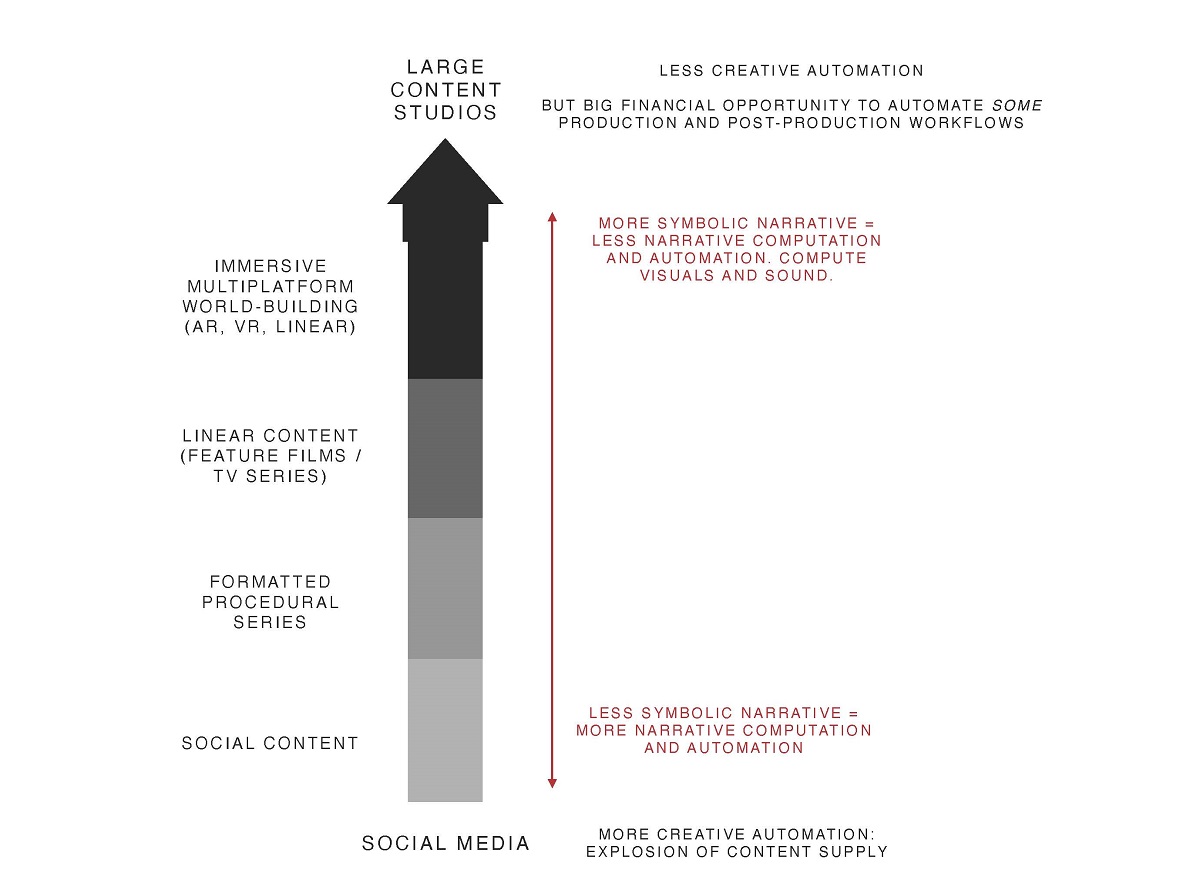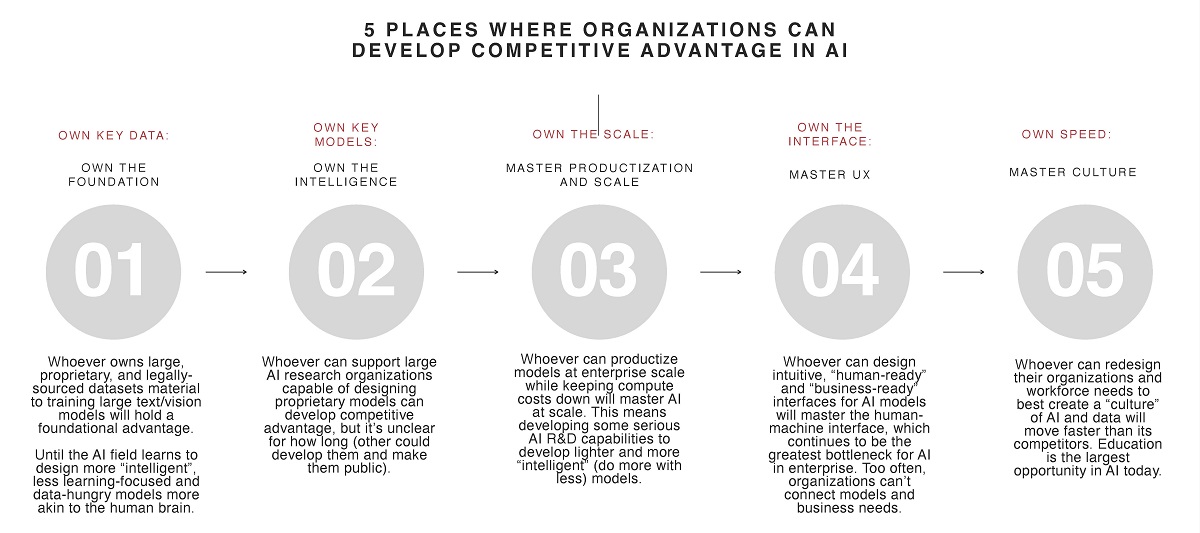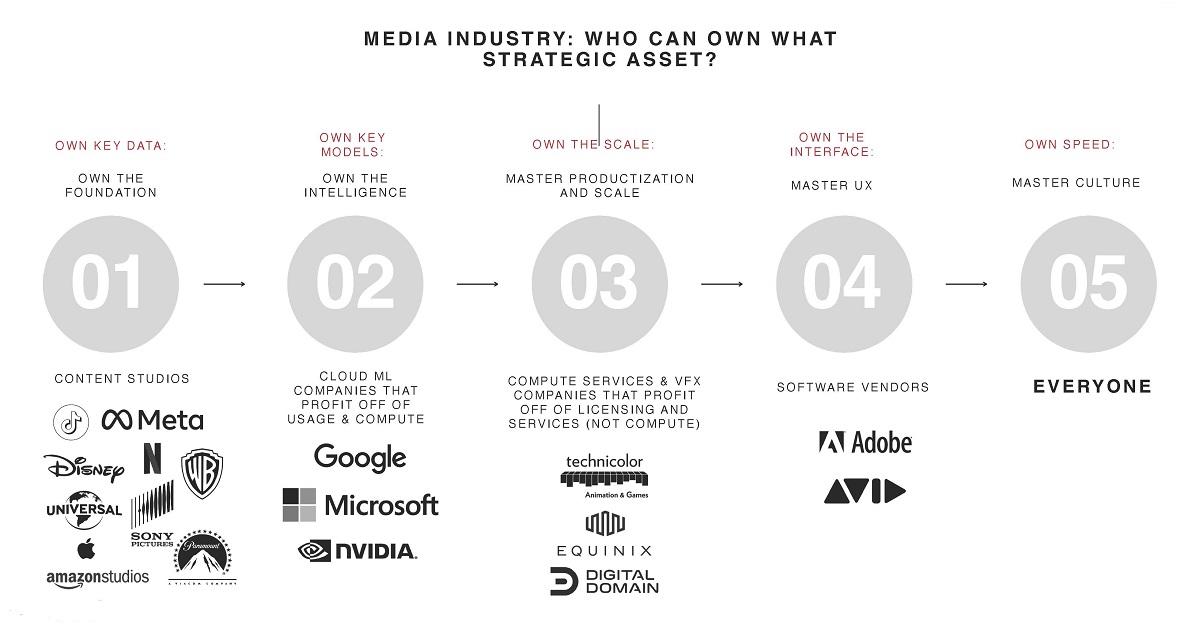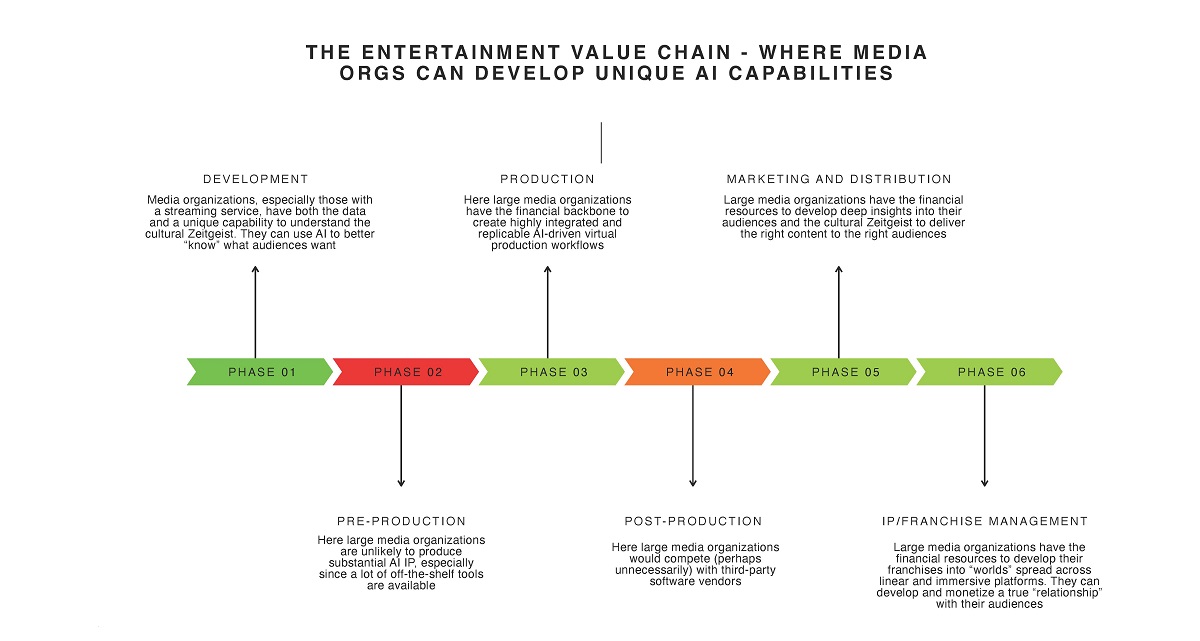
TL;DR
- A new report from studio-funded thinktank ETC, “AI & Competitive Advantage in Media,” authored by the org’s resident data scientist and AI expert, Yves Bergquist, explores the impact of generative AI on the media.
- Bergquist argues that generative AI impacts the media industry less by disrupting its traditional content creation process and more by giving social content creators the tools to make large amounts of truly cinematic, studio-like content.
- Social media’s strength is its enormous library of content, which allows it to conduct millions of content market-fit experiments per minute.
- There’s still a place for deliberate, curated, data-driven development decisions about what audiences want to see, but studio-style content needs to be integrated and immersive.
The single biggest impact of generative AI for large content producers and distributors isn’t about disrupting the media-making process. It’s that it gives its fiercest competitors — content creators on YouTube and TikTok — more tools to eat further into everyone’s daily video consumption that the media industry is battling for.
According to a fresh report by studio-funded thinktank ETC, “AI and Competitive Advantage in Media,” generative AI “potentially disrupts the already unfortunate economics of the media business: stable demand (never more than 24 hours in a day) and exploding supply.”
In the report, Yves Bergquist, ETC’s resident data scientist and AI expert, argues that what’s happening in the media industry is proximate to what already happened in manufacturing: automation of the craft of making a product (i.e., making the product computable).
By computable they mean that content is produced in volume and is “machine readable” in terms of every aspect of its creation to distribution to feedback from audiences being data and therefore available for dissection
Traditional media companies currently are not “computable” in the sense that they produce products linearly, one at a time. It is scarce, whole, long-form (not conducive to being sliced and diced by an online audience) and unstructured (its narrative DNA is not yet machine-readable).
This is going to have to change if studios and streamers want to part of the bigger picture in a few years’ time.
ETC divides the creative process into three parts. Bergquist dubs the ideation part, where creatives “sense” what an audience wants to see, “zeitgeist intelligence.”
Then there’s the core of the creative process, where creatives define their voices and make strategic decisions about what product will be crafted.
Finally, the product is made.
AI’s immediate impact is on that final phase. But by automating production, “Generative AI not only puts more emphasis on Zeitgeist-sensing and creative decision-making, it gives creative decision-makers tools to quickly and cheaply tinker, experiment, and prototype.”
At the same time, traditional media companies “risk losing their monopoly on the craft of high-quality content.”
Generative AI empowers social creatives to quickly and cheaply craft “studio quality” content threatening the status of traditional media. They can do this because their knowledge of what the audience wants is crowdsources by links, likes and recommendation algorithms. The content produced is computable in the sense that it can all be digitally mined. And the scale of content production means there’s enough supply to fit cater for every audience whim.
But ETC spots a weakness. Social media platforms and content creators reliant on those platforms lack any real understanding of their audience, claims ETC. It is just “basic content match-making”.
Instead, studios and especially streamers, can strike back against pure AI content generators by using the data they have at their disposal more intelligently.
“Programmatic content distributors like TikTok match content with audiences without any semantic understanding of why this content resonates. It’s just a programmatic marketplace that computes the content de facto.”
With generative AI bringing high production value tools to social creators, we can expect a new category of “short-form linear content” to emerge on social platforms.
Studios, on the other hand, “have the longest experience and the largest dataset available to not only develop an intelligence go their audiences, but to draw them into a deep relationship with their franchises.”
Media organizations, “especially those with a streaming service,” have both the data and a unique capability to understand the cultural zeitgeist. They can use AI to better “know” what audiences want, Bergquist says.
ETC also suggests that it’s the large media organizations that have the financial backbone “to create highly integrated and replicable AI-driven virtual production workflows.”
It contends that traditional media players will need to differentiate through immersive, multi-platform, world-building franchises, a trend they are already pursuing of course.
This, says ETC, “is the greatest opportunity for large media organizations to leverage virtual production and generative AI together to quicken and cheapen the cost of producing these multi-format immersive pieces. This new form of computable content will run on game engines.”
In so doing, this “revolutionizes the way stories are told,” with integrated narratives spun across linear and immersive media products.
There are warnings, though.
“Media organizations don’t have a software culture, nor can they support large AI R&D assets. They could partner with (or acquire) key AI research organizations to leverage their data to create their own proprietary content and audience intelligence models, but this is a heavy lift.”
ETC also identifies a need for intuitive “human-ready” and “business-ready” interfaces for AI models, which continues to be the greatest bottleneck for AI in enterprise. Too often, says Bergquist, organizations can’t connect models and business needs.
“Whoever can redesign their organizations and workforce needs to best create a ‘culture’ of AI and data will move faster than its competitors.”
Education, insists ETC, is the largest opportunity in AI today.
While everyone seems to agree AI represents a big financial opportunity to automate some production and postproduction workflow it begs a question: Does taking knowledge of the craft out of creative work affect creative decisions and creative output overall? Or, put another way, does knowing the craft make a creative a better decision-maker? ETC has no answers for this, and perhaps we’ll only find out in time.
More globally, what the media industry needs right now is a distinct and actionable AI vision.












Discussion
Responses (1)